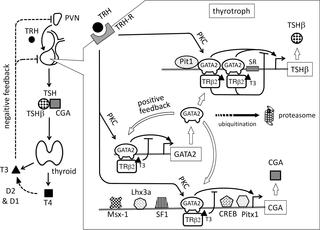Our official English website, www.x-mol.net, welcomes your
feedback! (Note: you will need to create a separate account there.)
Liganded T3 receptor β2 inhibits the positive feedback autoregulation of the gene for GATA2, a transcription factor critical for thyrotropin production.
PLOS ONE ( IF 2.9 ) Pub Date : 2020-01-15 , DOI: 10.1371/journal.pone.0227646 Naoko Hirahara 1 , Hiroko Misawa Nakamura 2 , Shigekazu Sasaki 2 , Akio Matsushita 2 , Kenji Ohba 3 , Go Kuroda 2 , Yuki Sakai 2 , Shinsuke Shinkai 2 , Hiroshi Haeno 4 , Takuhiro Nishio 5 , Shuichi Yoshida 5 , Yutaka Oki 6 , Takafumi Suda 2
PLOS ONE ( IF 2.9 ) Pub Date : 2020-01-15 , DOI: 10.1371/journal.pone.0227646 Naoko Hirahara 1 , Hiroko Misawa Nakamura 2 , Shigekazu Sasaki 2 , Akio Matsushita 2 , Kenji Ohba 3 , Go Kuroda 2 , Yuki Sakai 2 , Shinsuke Shinkai 2 , Hiroshi Haeno 4 , Takuhiro Nishio 5 , Shuichi Yoshida 5 , Yutaka Oki 6 , Takafumi Suda 2
Affiliation

|
The serum concentration of thyrotropin (thyroid stimulating hormone, TSH) is drastically reduced by small increase in the levels of thyroid hormones (T3 and its prohormone, T4); however, the mechanism underlying this relationship is unknown. TSH consists of the chorionic gonadotropin α (CGA) and the β chain (TSHβ). The expression of both peptides is induced by the transcription factor GATA2, a determinant of the thyrotroph and gonadotroph differentiation in the pituitary. We previously reported that the liganded T3 receptor (TR) inhibits transactivation activity of GATA2 via a tethering mechanism and proposed that this mechanism, but not binding of TR with a negative T3-responsive element, is the basis for the T3-dependent inhibition of the TSHβ and CGA genes. Multiple GATA-responsive elements (GATA-REs) also exist within the GATA2 gene itself and mediate the positive feedback autoregulation of this gene. To elucidate the effect of T3 on this non-linear regulation, we fused the GATA-REs at -3.9 kb or +9.5 kb of the GATA2 gene with the chloramphenicol acetyltransferase reporter gene harbored in its 1S-promoter. These constructs were co-transfected with the expression plasmids for GATA2 and the pituitary specific TR, TRβ2, into kidney-derived CV1 cells. We found that liganded TRβ2 represses the GATA2-induced transactivation of these reporter genes. Multi-dimensional input function theory revealed that liganded TRβ2 functions as a classical transcriptional repressor. Then, we investigated the effect of T3 on the endogenous expression of GATA2 protein and mRNA in the gonadotroph-derived LβT2 cells. In this cell line, T3 reduced GATA2 protein independently of the ubiquitin proteasome system. GATA2 mRNA was drastically suppressed by T3, the concentration of which corresponds to moderate hypothyroidism and euthyroidism. These results suggest that liganded TRβ2 inhibits the positive feedback autoregulation of the GATA2 gene; moreover this mechanism plays an important role in the potent reduction of TSH production by T3.
中文翻译:

固定的T3受体β2抑制GATA2基因的正反馈自动调节,GATA2是促甲状腺素生成的关键转录因子。
甲状腺激素(T3及其原激素,T4)的少量增加会大大降低甲状腺促甲状腺素(甲状腺刺激激素,TSH)的血清浓度。但是,这种关系的潜在机制尚不清楚。TSH由绒毛膜促性腺激素α(CGA)和β链(TSHβ)组成。两种肽的表达都是由转录因子GATA2诱导的,GATA2是垂体中甲状腺营养和性腺营养分化的决定因素。我们先前曾报道配体T3受体(TR)通过束缚机制抑制GATA2的反式激活活性,并提出该机制(但TR与负T3响应元件不结合)是T3依赖性抑制T3受体的基础TSHβ和CGA基因。GATA2基因本身也存在多个GATA反应元件(GATA-RE),并介导该基因的正反馈自调控。为了阐明T3对这种非线性调节的影响,我们将GATA2基因-3.9 kb或+9.5 kb处的GATA-RE与1S启动子中携带的氯霉素乙酰基转移酶报告基因融合在一起。将这些构建体与用于GATA2的表达质粒和垂体特异性TR,TRβ2共转染到肾源性CV1细胞中。我们发现,配体TRβ2抑制了这些报道基因的GATA2诱导的反式激活。多维输入功能理论揭示,配体TRβ2具有经典的转录阻遏物功能。然后,我们研究了T3对源自性腺营养的LβT2细胞中GATA2蛋白和mRNA内源性表达的影响。在此细胞系中,T3会独立于泛素蛋白酶体系统还原GATA2蛋白。T3大大抑制了GATA2 mRNA的表达,其浓度相当于中度甲状腺功能减退和甲状腺功能正常。这些结果表明配体TRβ2抑制了GATA2基因的正反馈自调控。此外,该机制在有效减少T3产生的TSH方面起着重要作用。
更新日期:2020-01-16
中文翻译:

固定的T3受体β2抑制GATA2基因的正反馈自动调节,GATA2是促甲状腺素生成的关键转录因子。
甲状腺激素(T3及其原激素,T4)的少量增加会大大降低甲状腺促甲状腺素(甲状腺刺激激素,TSH)的血清浓度。但是,这种关系的潜在机制尚不清楚。TSH由绒毛膜促性腺激素α(CGA)和β链(TSHβ)组成。两种肽的表达都是由转录因子GATA2诱导的,GATA2是垂体中甲状腺营养和性腺营养分化的决定因素。我们先前曾报道配体T3受体(TR)通过束缚机制抑制GATA2的反式激活活性,并提出该机制(但TR与负T3响应元件不结合)是T3依赖性抑制T3受体的基础TSHβ和CGA基因。GATA2基因本身也存在多个GATA反应元件(GATA-RE),并介导该基因的正反馈自调控。为了阐明T3对这种非线性调节的影响,我们将GATA2基因-3.9 kb或+9.5 kb处的GATA-RE与1S启动子中携带的氯霉素乙酰基转移酶报告基因融合在一起。将这些构建体与用于GATA2的表达质粒和垂体特异性TR,TRβ2共转染到肾源性CV1细胞中。我们发现,配体TRβ2抑制了这些报道基因的GATA2诱导的反式激活。多维输入功能理论揭示,配体TRβ2具有经典的转录阻遏物功能。然后,我们研究了T3对源自性腺营养的LβT2细胞中GATA2蛋白和mRNA内源性表达的影响。在此细胞系中,T3会独立于泛素蛋白酶体系统还原GATA2蛋白。T3大大抑制了GATA2 mRNA的表达,其浓度相当于中度甲状腺功能减退和甲状腺功能正常。这些结果表明配体TRβ2抑制了GATA2基因的正反馈自调控。此外,该机制在有效减少T3产生的TSH方面起着重要作用。











































 京公网安备 11010802027423号
京公网安备 11010802027423号